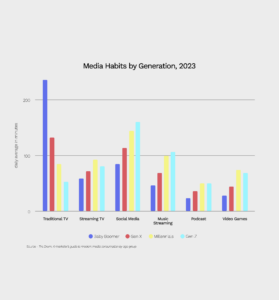For the fourth installment of our Countdown to the Cookieless Future, we’re getting into the nitty gritty. We address top concerns advertisers have about what their campaign planning and execution will look like as we move away from Google’s third-party cookies. Victoria de Leon, Director of Marketing is joined by Ariel Howard, VP of Campaign Solutions, and Addy Osborne, Sr. Strategist, Planning & Insights, seasoned digital marketing experts who have been at the forefront of adapting to changes brought about by privacy regulations and technological shifts. Ready to dive in? Hit play on the video to learn more or check out our overview of the video content below.
Short on time? Listen to or download the content of this episode on Spotify.
Addressing Advertiser Concerns and Strategies in a Cookieless World
To kickstart the conversation, de Leon asks the panelists to address their in-market experience and what they’re hearing from clients with the question:
What are some of the top concerns you hear from advertisers about the removal of third-party cookies?
Osborne opens the conversation by stating the primary concerns among advertisers revolve around the loss of precise targeting and retargeting capabilities that third-party cookies provide. She highlights that advertisers are worried about decreases in campaign effectiveness and increases in customer acquisition costs. The uncertainty about new tools and standards that will replace cookies also adds to the anxiety within the industry.
—
So as not to leave advertisers questioning how they’ll solve for some of these concerns, de Leon moves the conversation toward tangible steps advertisers can take with the question:
What advice do you have for advertisers actively transitioning toward cookie-free tactics?
Howard recommends that advertisers start experimenting with alternative solutions as soon as possible. She emphasize the importance of diversifying data collection strategies by enhancing direct interactions with customers through owned channels. Additionally, she suggests investing in technology that supports advanced data analytics and AI-driven insights to compensate for the gaps left by the disappearance of cookies.
—
de Leon prompts the panelists to dive further into the topic of diversifying data, specfically with the use of first-party data and CRM-based campaigns, with a two-part question:
Can you explain more about CRM-based campaigns leveraging first-party data and how performance typically looks? Are there any best practices advertisers should keep in mind?
Howard doubles down on the notion that CRM-based campaigns that leverage first-party data are becoming increasingly crucial. These campaigns often see robust engagement rates as they are based on higher-quality, consent-based data. She provides best practices when using first-party data which include maintaining transparent data collection methods, regularly updating data to ensure accuracy, and creating personalized content that resonates with the audience’s current needs and interests.
—
Moving the conversation toward additional future-proof strategies advertisers can use, de Leon asks:
What other data types, channels, and tactics would you recommend to reach audiences post-cookie depreciation?
Osborne offers a wide variety of tactics and solutions for advertisers to consider. She encourages advertisers to look beyond traditional online channels and offers tangible solutions across data, tactics, and channels. She recommends combining offline, purchase & transactional, and owned media (such as retail media networks and walled gardens) data to ensure robust options for reaching consumers. She highlights the potential of contextual advertising, search retargeting, keyword targeting, custom site lists & Private marketplaces, and location targeting as viable targeting tactics not reliant on third-party cookies. Finally, she encourages using inherently cookieless channels such as advanced TV, advanced audio, retail media, and walled gardens.–
To close the conversation, de Leon asks the panelist to address another concern that was mentioned at the top of the conversation with the question:
How will these changes impact measurement and performance metrics across different channels?
Howard states that the transition away from third-party cookies necessitates the development of new metrics and KPIs focused on privacy-first strategies. She discusses the need for more aggregated data reporting and probabilistic models to understand campaign performance. Finally, she notes that she also foresee a greater reliance on brand lift studies and customer satisfaction surveys to gauge the effectiveness of advertising efforts.










